Posts by Ethan Kind
Harp – Making Technique Changes AND Letting Go of What Isn’t Working (Musicians)(Psychology)(Pain)(Strain)(Injuries)(Posture)(Alexander Technique)(Albuquerque)
This ebook, An Alexander Technique Approach to Harp Technique, is published on this website in a PDF format. It is very detailed and practical, and it will give you the physical tools you need to take the limits off of your ability to create the accurate harp technique you want without sacrificing your body.
This ebook is also for sale on all AMAZON websites in a KINDLE format.
Located in Albuquerque, New Mexico, U.S.A. (MOVEMENT THERAPY)
There is a very profound thing that the Alexander Technique does for harpists. It simultaneously teaches the harpist how to do something new and let go of something old at the same time. The more I delve into this, the more unique and profound I realize it is. Let me explain.
IF YOU DON’T LET GO WHAT ISN’T WORKING IN YOUR HARP TECHNIQUE, AS YOU LEARN SOMETHING NEW IN YOUR HARP TECHNIQUE, THEN YOU WILL COMPROMISE THE CHANGES YOU MAKE AND KEEP THE NEW FROM WORKING.
I see this as physical, psychological, and spiritual. There is spiritual book called A Course in Miracles. The most famous saying that many people know from A Course in Miracles is, “Love is letting go of fear”.
As a harpist, love is letting go of what is compromising your harp technique, which means letting go of what is creating physical limitations in your harp playing.
How do you know if you’re doing something changeable on the harp, or if you have built in limitations to your playing? Let me restate this. How WILL you know if much of what appears to be in your way in your harp technique is inherent or learned, if you don’t attempt to let it go?
Ex: Play a two octave scale on the harp, at a moderately fast tempo. Now play it with the most tension possible in your fingers, hands, forearms, and shoulders at a moderately fast tempo. Now play it with the least amount of tension possible in your fingers, hands, forearms, and shoulders at a moderately fast tempo.
Repeat the above as many times you wish, noticing the effects of the increased and lowered tension on your playing the harp. Question: Were you able to consciously raise and lower the tension level in your fingers, hands, forearms, and shoulders?
Congratulations! You’ve just had your first Alexander Technique lesson. You just discovered you have conscious control over what is fairly invisible to many harpists, but is one of the main culprits in making you think you have limited talent on the harp.
So, let’s say you go to a wonderful harp teacher who makes very visible changes to your posture and technique on the harp, and all of these changes are valid. Will they work?
THE BEST TECHNIQUE CHANGES TO YOUR HARP TECHNIQUE WILL NOT WORK, IF THE “INVISIBLE” OLD HABITS THAT COMPROMISED YOUR PLAYING IN THE FIRST PLACE ARE NOT CONSCIOUSLY RELEASED, INHIBITED, AS THEY SAY IN THE ALEXANDER TECHNIQUE.
Here’s a word of encouragement. If you go to an Alexander Technique teacher, and he or she makes big changes to your posture and underlying habits on the harp, then you have been limiting your own talent in a big way, so you are not lacking in what it takes to be a fine player.
